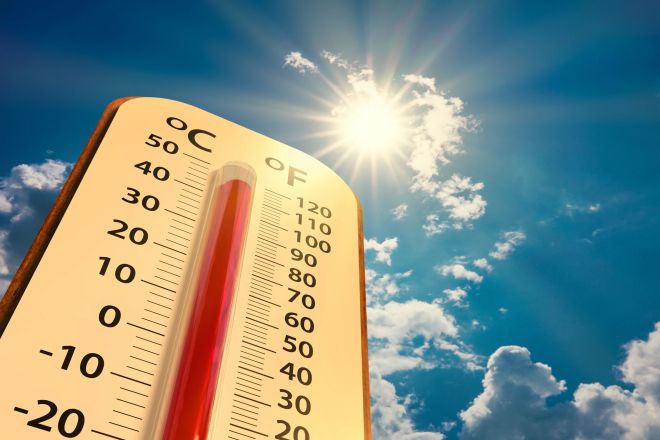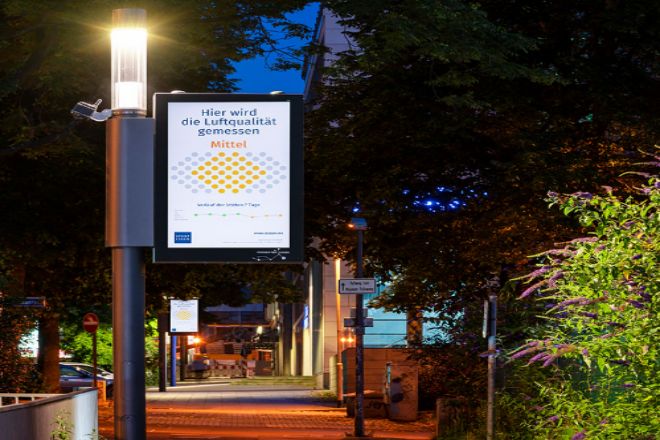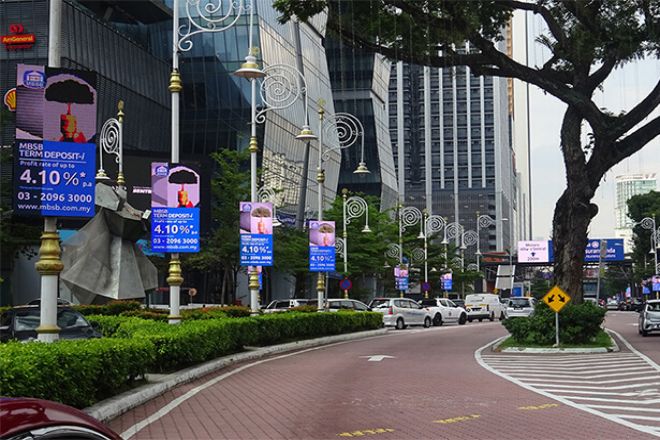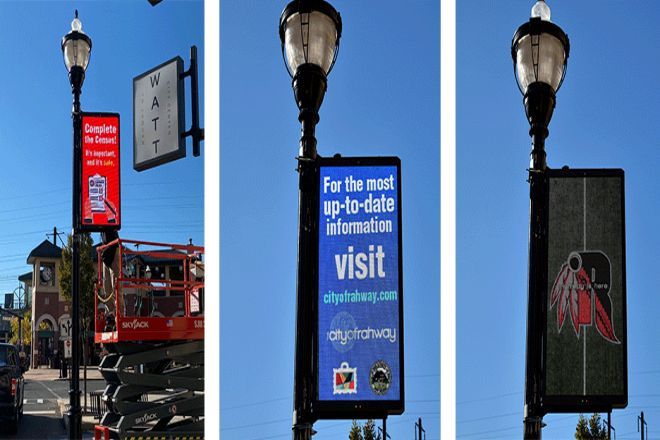Introduction

In the hot summer, high-temperature weather has become the norm, which poses a severe test for outdoor electronic equipment, especially pole LED display screens.
As an important part of the information construction of modern cities, Affichage LED sur poteau screens are widely used in traffic guidance, information release, publicité, and other fields with their advantages of high brightness, wide viewing angle, and easy installation.
However, high temperatures will not only affect the luminous efficiency and life of LED display screens but also threaten their stability and reliability, thus affecting their normal operation and service life.
Therefore, it is of great practical significance and practical application value to study how pole LED display screens can effectively cope with high-temperature weather and ensure their stable operation in high-temperature environments.
1. Introduction to pole LED display screens

Pole LED display screens, which we often call lamp pole LED display screens, play a vital role in outdoor advertising and public information release.
These display screens are cleverly installed on street lamp poles or other public facilities, which not only make full use of urban space but also enrich the visual landscape of the city in a unique way.
1). Brief description of key roles:
- Bridge for information dissemination:
Lamp pole LED display screens are an important bridge connecting information publishers and the public.
Whether it is commercial advertising, public welfare propaganda, or emergency notices, these displays can quickly convey information to pedestrians and vehicles passing by, ensuring wide coverage and timely communication of information.
- Enhance visual appeal:
Since light pole LED displays are usually located in places with large traffic, and have the characteristics of high luminosité and bright colors, they can easily attract people’s attention.
This strong visual impact makes the advertising content more memorable and improves the publicity effect.
- Flexible adaptation to the environment:
The design of light pole LED displays is flexible and diverse and can be customized according to different environments and needs. Whether it is a narrow street or a wide square, you can find a suitable location for installation to achieve effective dissemination of information.
2. What are the effects of high temperatures on pole-mounted LED displays?
The effect of high temperature on pole-mounted LED displays (the dazzling large screen on street lamp poles) is actually similar to the discomfort we feel in the hot summer. The screen will also experience a “high temperature test”, as if it is also experiencing a “heat stroke” challenge.
1). Immediate problems that may be encountered under high temperatures
- Screen “sweating”:
Under strong direct sunlight, the electronic components inside the pole LED display seem to be in a furnace, and they begin to accumulate heat, just like the human body sweating in the hot summer.
This accumulation of heat not only causes the surface temperature of the screen to rise sharply but is also likely to cause overheating of the internal circuit boards and electronic components.
Overheating not only affects the normal operation of these components but may also cause a series of faults, such as short circuits and open circuits, which in turn affect the performance and stability of the entire display.
- Dim brightness:
The high-temperature environment is like putting an invisible yoke on the LED lamp beads, limiting their ability to emit light. The luminous efficiency of LED chips is closely related to temperature, and when the temperature rises, its luminous efficiency will be significantly reduced.
This means that at high temperatures, the brightness of the pole LED display will drop significantly, blurring the originally clear text and images and greatly reducing the viewing comfort and the communication effect of information.
- Color distortion, visual feast changes:
High temperatures can also have an adverse effect on the color performance of LED displays. Since the wavelength of the LED chip will shift with the change in temperature, the color that should be presented will become inaccurate.
For example, bright red may become dull and orange, and clear blue may become turbid and purple.
This color distortion not only destroys the beauty of the picture but also may mislead the audience’s understanding of the information and affect the accurate communication of the information.
2). Long-term impact
- Material aging, youth is no longer:
The materials inside the pole LED display, including LED packaging materials, circuit boards, electronic components, etc., will gradually lose their original performance and stability under a long-term high-temperature environment.
They will gradually lose elasticity and become fragile and vulnerable, like skin exposed to the sun. The aging process of this material is irreversible and will seriously shorten the service life and stability of the display.
- Life is drastically reduced, and frequent replacement becomes the norm:
High temperature is like a ruthless accelerator. It accelerates the aging process of the pole LED display, causing the display that was originally designed to have a long life to have performance degradation and frequent failures in a short period of time.
This not only increases the user’s maintenance and use costs, but also may affect the continuous release and dissemination of information due to frequent replacement and repair.
3.Precautions for pole LED display screens in hot weather

Preventive maintenance of pole LED display screens is essential in hot weather to ensure stable operation and extend service life. Here are some specific preventive maintenance recommendations:
1). Regularly check the cooling system of the display screen
- Cooling system inspection:
The cooling system is the key to the normal operation of the pole LED display screen in a high-temperature environment.
Regularly check whether the cooling fan, heat sink, and other components are working properly to ensure that there is no blockage or dust accumulation.
Compressed air or a professional vacuum cleaner can be used to clean the cooling system to maintain its good heat dissipation performance.
- Surveillance de la température :
A temperature sensor is used to monitor the temperature inside the display screen in real-time.
Once the temperature is found to be too high, measures should be taken immediately to cool it down, such as adding cooling equipment or adjusting the working mode of the display screen.
2). Ensure that the display screen is installed in an appropriate location
- Avoid direct sunlight:
When installing a pole LED display screen, try to choose a location that avoids direct sunlight to reduce the direct heating of the display screen by solar radiation. If direct sunlight cannot be avoided, other measures can be taken to block it.
- Consider ventilation conditions:
When choosing an installation location, also ensure that there are good ventilation conditions around it so that the heat generated by the display screen can be dissipated in time.
3). Use sun visors or sunshade nets to reduce direct sunlight
- Install sun visors:
Installing sun visors above the display screen can effectively block direct sunlight and reduce the temperature of the display screen surface.
The sun visor should be made of high-temperature-resistant and corrosion-resistant materials to ensure its long-term stability.
- Use sunshade nets:
In addition to sun visors, sunshade facilities such as sunshade nets can also be used. The sunshade net not only has a sunshade effect but also a certain ventilation effect, which helps to dissipate heat.
4. Maintenance and care of pole LED display screens in hot weather
For the maintenance of pole LED display screens at high temperatures, we need to take a series of special measures to ensure that they can still operate stably and extend their service life under extreme temperatures. The following are some key maintenance steps and strategies:
1). Strengthen heat dissipation management
- Check the heat dissipation system:
First, regularly check whether the heat dissipation components, such as the heat dissipation fan and heat sink of the display screen, are operating normally to ensure that there is no blockage or dust accumulation.
Compressed air or a vacuum cleaner can be used to clean and improve heat dissipation efficiency.
- Optimize the installation location:
If possible, install the display screen in a location with good ventilation conditions and avoid direct sunlight. If the location is fixed, you can consider adding shading facilities, such as awnings, shading nets, etc., to reduce the heat from direct sunlight.
- Add cooling auxiliary equipment:
In extremely hot weather, you can consider adding additional cooling equipment to the display, such as industrial-grade cooling fans, heat pipe radiators, etc., to enhance the cooling effect.
2). Regularly check the electrical system
- Check the power supply and signal lines:
Make sure that the power lines and signal lines are firmly connected and free of aging and damage. Check the electrical insulation performance to prevent electrical failures caused by high temperatures.
- Power supply stability:
High temperature may cause power instability, so the stability of the power supply voltage and current should be checked regularly to ensure that the display works in a stable power supply environment.
3). Monitoring and adjustment
- Surveillance de la température :
Install a temperature sensor to monitor the temperature inside the display in real-time. Once the temperature exceeds the safety threshold, take immediate measures to cool it down.
- Brightness and working time adjustment:
In hot weather, appropriately reduce the brightness of the display and reduce the working time to reduce heat generation and accumulation.
At the same time, the working state of the display can be automatically adjusted according to the ambient temperature through the intelligent control system.
4). Replace aging parts
- Seals and heat dissipation materials:
Regularly check and replace aging seals and heat dissipation materials to ensure the sealing and heat dissipation performance of the display.
- Electronic components:
Electronic components that have aged due to high temperature, such as LED lamp beads, driver chips, etc., should be replaced in time to prevent the expansion of faults.
5. Emergency response strategies

1). Quickly cool down the display
- Use a fan to blow:
Imagine that you feel very hot under the sun. If someone fans you, will you feel cooler? In the same way, you can install a large fan on the display and blow it to let the wind take away the heat from the display and help it cool down quickly.
- Build a sunshade:
If the display is outdoors, just like you will get heatstroke if you stand in the sun for a long time, the display will also be very hot.
At this time, you can quickly build a sunshade or hang a sunshade net to block direct sunlight, just like a parasol for the display to make it cooler.
2). Reduce the workload of the display
- Reduce the brightness and contrast:
Just like you dim the lights when reading at night, we can reduce the brightness and contrast of the display. The advantage of this is that the display will not work so hard, and the heat generated will be reduced.
- Switch to energy-saving mode:
Some displays have an energy-saving mode, just like the power-saving mode of mobile phones. After turning on this function, the display will become more “power-saving”; that is, unnecessary energy consumption is reduced, and naturally, heat generation is reduced.
- Reduce working hours:
If the display does not need to be on all the time, then you can consider reducing its working time. For example, it was originally turned on all day, but now it is only turned on for a while when needed, which can also reduce the burden on the display and prevent overheating.
3). Pay close attention to the status of the display
- Install a thermometer:
You can put a thermometer next to the display, or more advanced, directly install a temperature sensor inside the display. In this way, you can always know the temperature of the display, and once the temperature is too high, you can immediately detect and take measures.
- Set a warning line:
You can set a temperature warning line in advance, such as 70℃. Once the temperature of the display reaches or exceeds this warning line, you know you need to act quickly, either to cool it down or adjust the working mode.
4). Prepare a plan to deal with emergencies
- Establish an emergency team:
You can set up an emergency team in advance, including technicians and maintenance personnel. In this way, once there is a problem with the display, they can quickly rush to the scene to solve the problem.
- Prepare spare equipment:
Just like you will prepare spare light bulbs at home, you can also prepare a spare display. In this way, if the main display has a serious problem and cannot be used, you can quickly replace it with a spare display to ensure normal use.
Conclusion
In summary, the stable operation of the pole LED display in hot weather is inseparable from scientific heat dissipation design, perfect environmental control system, high-quality material selection, and strict testing and quality control.
With the advancement of science and technology and the development of the industry, we have reason to believe that the future pole LED display will be more adaptable to various complex environments, bringing more convenience and surprises to the construction of smart cities and people’s lives.
Enfin, si vous souhaitez en savoir plus sur les écrans LED, veuillez nous contacter.
